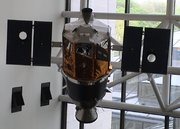Satellite
|
|
A satellite is an object that orbits another object (known as its primary). The term is often used to describe an artificial satellite (as opposed to natural satellites, or moons).
Because all objects exert gravity, the motion of the primary object is also affected by the satellite. (This observation allows for the discovery of extrasolar planets.) If two objects are sufficiently similar in mass, they are generally referred to as a binary system rather than a primary object and satellite. The general criterion for an object to be a satellite is that the center of mass of the two objects is inside the other object.
All masses that are part of the solar system, including the Earth, are satellites of the Sun, or satellites of those objects, such as the Moon.
Venera-7_diagram.jpg
| Contents |
Artificial satellites
History of artificial satellites
In May, 1946, the Preliminary Design of an Experimental World-Circling Spaceship stated, "A satellite vehicle with appropriate instrumentation can be expected to be one of the most potent scientific tools of the Twentieth Century. The achievement of a satellite craft would produce repercussions comparable to the explosion of the atomic bomb..." (see: Project RAND)
The space age began in 19461, as scientists began using captured German V-2 rockets to make measurements in the upper atmosphere. Before this period, scientists could use balloons up to 30 km and radio waves to study the ionosphere; rockets changed that. From 1946 to 1952, upper-atmosphere research was conducted using V-2s and Aerobee rockets. This allowed measurements of atmospheric pressure, density, and temperature up to 200 km. (see also: magnetosphere, Van Allen radiation belt)
The U.S. had been considering launching orbital satellites since 1945 under the Bureau of Aeronautics of the United States Navy. The Air Force's Project RAND eventually released the above report, but did not believe that the satellite was a potential military weapon; rather they considered it to be a tool for science, politics, and propaganda. In 1954, the Secretary of Defense stated, "I know of no American satellite program."
Following pressure by the American Rocket Society, the National Science Foundation, and the International Geophysical Year, military interest picked up and in early 1955 the Air Force and Navy were working on Project Orbiter, which involved using a Jupiter C rocket to launch a small satellite called Explorer 1 on January 31, 1958.
On July 29, 1955, the White House announced that the U.S. intended to launch satellites by the spring of 1958. This became known as Project Vanguard. On July 31, the Soviets announced that they intended to launch a satellite by the fall of 1957 and on October 4, 1957 Sputnik I was launched into orbit, which triggered the Space Race between the two nations.
The largest artificial satellite currently orbiting the earth is the International Space Station, which can sometimes be seen with the human eye.
Types of satellites
Astronomical satellites are satellites used for observation of distant planets, galaxies, and other outer space objects.
Communications satellites are artificial satellites stationed in space for the purposes of telecommunications using radio at microwave frequencies. Most communications satellites use geosynchronous orbits or near-geostationary orbits, although some recent systems use low Earth-orbiting satellites.
Earth observation satellites are satellites specifically designed to observe Earth from orbit, similar to reconnaissance satellites but intended for non-military uses such as environmental monitoring, meteorology, map making etc.
Navigation satellites are satellites which use radio time signals transmitted to enable mobile receivers on the ground to determine their exact location. The relatively clear line of sight between the satellites and receivers on the ground, combined with ever-improving electronics, allows satellite navigation systems to measure location to accuracies on the order of a few metres in real time.
Reconnaissance satellites are Earth observation satellite or communications satellite deployed for military or intelligence applications.
Solar power satellites are proposed satellites built in high Earth orbit that use microwave power transmission to beam solar power to very large antenna on Earth where it can be used in place of conventional power sources.
Space stations are man-made structures that are designed for human beings to live on in outer space. A space station is distinguished from other manned spacecraft by its lack of major propulsion or landing facilities — instead, other vehicles are used as transport to and from the station. Space stations are designed for medium-term living in orbit, for periods of weeks, months, or even years.
Weather satellites are satellites that primarily are used to monitor the weather and/or climate of the Earth.
Miniaturized satellites are satellites of unusually low weights and small sizes. New classifications are used to categorize these satellites: minisatellite (500–200 kg), microsatellite (below 200 kg), nanosatellite (below 10 kg).
See also
- Timeline of artificial satellites and space probes
- Satellites (by Launch Date)
- Satellite Services

